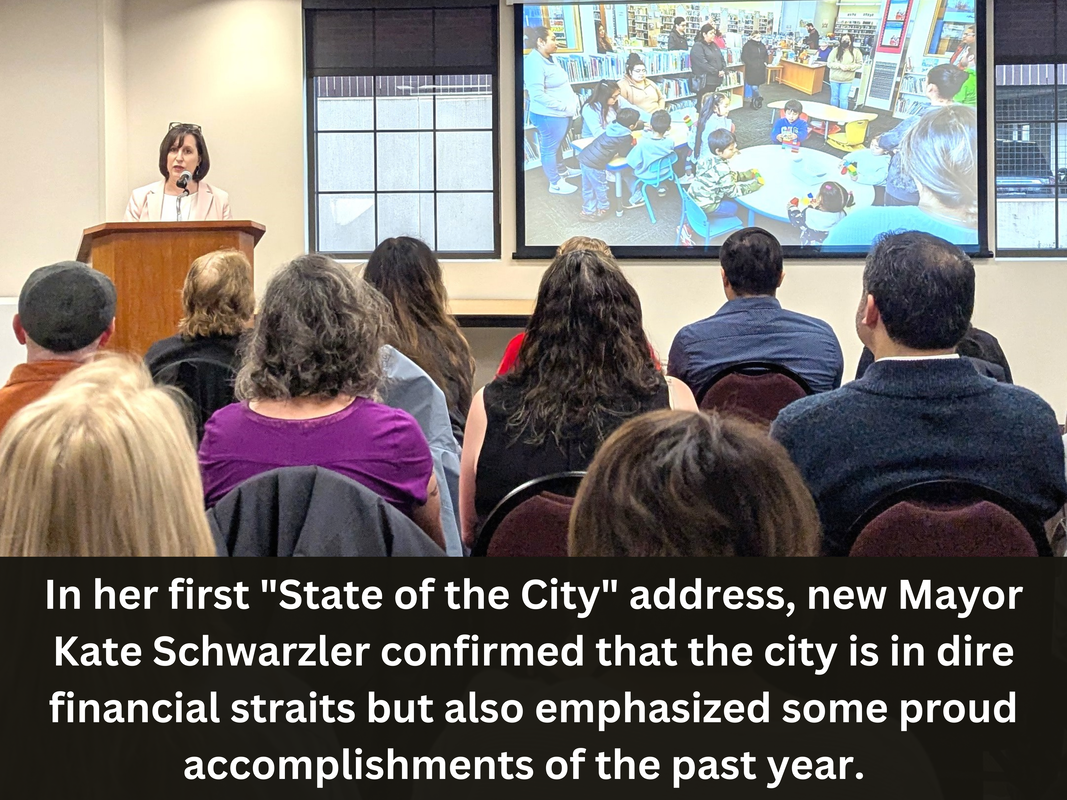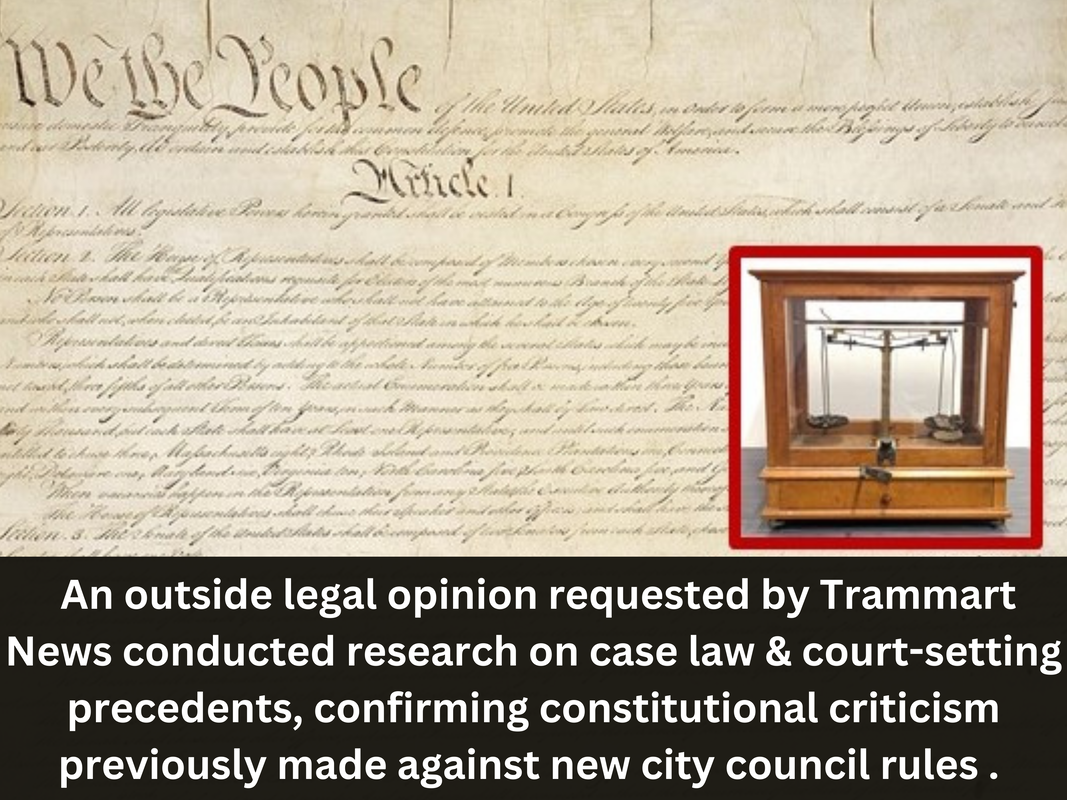
(Pictured: A recent work session on the challenges of a looming shortfall and decreasing city funds)
By Anne Scheck
Trammart News Service, March 28, 2025
A plan hatched by the Heritage Museum curator and the Independence Library director to combine the two departments in order to save them both appeared to receive the city council's blessing at a work session this week, though no formal action was taken.
The consensus came as councilors grappled with city finances. The total deficit for the city this fiscal year is predicted to be $776,000, putting city coffers under substantial strain before the first budget committee meeting in a few weeks time.
City Councilor Marilyn Morton praised Library Director Patrick Bodily and Heritage Museum Curator Amy Christensen for coming up with a workable proposal to move the museum into library space, hopefully on a temporary basis. Mayor Kate Schwarzler agreed that it seemed the most "fiscally responsible" alternative at hand.
Selling the museum building could net about $300,000, perhaps more, and the sale would put it back on the property tax rolls. "Hopefully we could get that building sold in the fiscal year," said City Manager Kenna West.
Under the current $85,000-a-year mortgage for the museum building plus other expenses, the annual savings would be substantial, according to the council discussion.
The concept was consistent with city-wide survey results, which showed low support for the museum. Of the 228 respondents to a survey of Independence residents, the most important departments were the library (53%), parks (42%), trailed by the museum at 6%. A large majority, 66%, favored reducing the museum department to cut costs, over parks and library.
Another annual saving will be through job attrition – the city's downtown manager has announced a departure this summer, after Independence Days, and her salary and benefits are about $100,000, annually. She won't be replaced by another paid employee taking the spot, West said.
The central question at the work session appeared to be how to maintain services at the museum, parks, library and planning and building inspections while closing the financial gap?
West said staff has been cut "to the bone." However, raises have been reported for personnel, no reductions in business travel have been announced, and staff was increased – a licensed engineer was added to public works, for example.
Also at the work-session meeting was a proposal to improve and upgrade the event center – with an estimated total ranging from $77,522 to $123,022. The event center, on the lower level of the Independence Civic Center, was reported at a previous city meeting as failing to generate any significant income for the city as a venue. (The proposal received no public discussion but was was printed in a handout at the meeting.)
Requests from Trammart News for clarification on raises, travel and personnel additions were made to Communications Director Emmanuel Goicochea but no response was received. In fact, one survey respondent appeared to identify Goicochea's position as unnecessary, stating that the closed municipal pool and other services are important but "we don't need high-quality videos for marketing on social media."
The budget sessions arrive as other sources of funding are diminished. Gone are covid "rescue" funds that infused Independence with a significant amount of extra money. Property taxes can no longer pay for city expenses, as personnel and material costs crept higher, and inter-fund transfers have been eliminated.
Other city revenue, such as charges to developers, has dried up, too. The city council nearly doubled those developer fees, pushing them past $50,000 per home-unit. Three of the builders told Trammart News they are no longer constructing houses in Independence as a result of the hikes, with no plans for returning.
Since then, City Manager West and City Public Works Director Gerald Fisher pushed forward a proposal for a new water-treatment plant – with an estimated cost of $44 million.
Two first steps toward the plan appear to be costing more than anticipated: The attempt to secure the land south of town for the plant by eminent domain led to legal wrangling and the sale of the parcel to another party; A $7.5 million loan that was initially announced as being sought from the state on low-interest terms was instead taken out as a line of credit through Umpqua Bank, more than doubling the interest rate typically available under the state's "revolving fund."
Additionally, sign-ons with other water districts as hoped-for partners across the county, including the nearby Luckiamute Domestic Water Cooperative, never took place – though Monmouth inked an intergovernmental agreement related to the project, according to those familiar with the document.
Now federal funding for the new treatment plant – once stated as a likely source of significant revenue – seems more questionable under the current presidential administration. ▪

(Pictured: An array of documents on city finances that don't yet include the annual city audit)
By Anne Scheck
Trammart News Service, March 28, 2025
A municipal audit by an outside accounting firm is required by the state – and due on the first day of the calendar year to the Oregon Secretary of State.
So far, there isn't a fiscal 2024 report on file for Independence; and no explanation from the city for the absence.
Why should a missing city audit cause concern? Here's an editorial analysis of the reasons for worry.
Financial transparency suffers without a timely municipal audit. An outside expert review is needed to confirm the financial status of the city. Depending on city officials to interpret finances may prove less reliable.
That's the unsurprising conclusion – that politicians aren't always the best assessors of city financial health – from a 2024 study on fiscal monitoring of municipalities across the United States, according to the Journal of the American Accounting Association.
One example in Independence: City administrators have, at times, been unclear in representing some of the tax-generated funds; A nearly $3.9 million loan of unknown cause was officially approved by the city council without clear explanation for how it was created because, as City Manager Kenna West explained, staff was too overloaded to track it down.
So the city council was asked to okay what was essentially an expenditure of unknown origin – which they did with two councilors opposing. Who identified the source of the loan last year? The outside auditor.
It was listed in the city's audit as payable to the city, a $3,867,234 sum. It was for additional costs of construction of the Independence Civic Center, which previously had been listed as costing about $10 million. Trammart News informed the city that, with the additional sums disclosed by the municipal audit, the price of the ICC – the city hall plus the lower-level event center – would be about $14 million. The new figure went unchallenged by the city finance director, Rob Moody.
Budget lapses may go unreported without a timely municipal audit. Accurate and timely audits are essential, according to the League of Oregon Cities, which weighed in about a decade ago on this finding with an analysis by lawyer Sean O'Day.
Oversight of what transpires following the budget is one reason city audits are important. There is a $776,000 shortfall this year in Independence, which appears to lack an explanation of precisely why.
Last year, then-city councilor Kate Schwarzler, who is now the mayor of Independence, called for sending an unfinished city budget back to city staff for preparation – taking it out of the hands of the budget committee, which, in addition to city councilors, is half-staffed by citizen volunteers. Her motion passed, with some committee members objecting.
That city budget committee had a relatively long list of cost-trimming proposals last year, many of which weren't publicly addressed. Observing this low-probing discussions in past years, a city administrator from another town said that perhaps this shouldn't have been surprising – the Independence City Council hasn't been functioning as a watchdog, he said.
This year the challenge to the city councilors is to "really do our homework so that when we get to the first budget committee meeting we have some actual ideas," Mayor Kate Schwarzler said at a recent work session on city finances.
Budget-balancing approaches may go unrecognized without a timely municipal audit. Without the required annual audit, strategies may escape notice or flaws may not be spotted early enough to take corrective action.
For example, in Monmouth – Independence's nearest city neighbor – the city audit this year included the recommendation for improving grant-tracking by doing it in real time, as grant spending actually occurs. Will that be included in the Monmouth budget, as a special task or for specific allocation of resources? It's a possibility.
The Monmouth city audit also shows successful use of inter-fund loans – in this case from the Sanitary Sewer Fund and the Power and Light Fund.
The Monmouth Sanitary Sewer Fund loan was for $500,000, signed in 2019, with an annual interest of 2.75% and was paid off in June 2024; The Monmouth Power and Light Fund loan was for $500,000, signed in 2016, with an annual interest of 2.54% and is scheduled to be paid off in July 2025. ▪
(Pictured: A yard with encroachment by dandelions that may or may not be able to remain)By Anne Scheck
Trammart News Service, March 28, 2025
They're bright yellow flowers and they're blooming all over. But they're not daffodils – and every year when they start appearing a certain minor battle begins.
They're dandelions and they unfailingly ignite the same springtime debate. They're weeds! No, they're essential pollinator plants! You need to get rid of them! No, you need to enable them to feed those bees!
This year, the dandelion divide line seems a little different than the last one, when gender seemed to play no role whatsoever. In 2025, it's been men on one side, women on the other.
The recent opinions were drawn from a sample size of about 10 – evenly split male-to-female, five to five – and findings from this random investigation are incredibly, even pathetically, non-scientific.
However, the viewpoints do provide some insight. Where are dandelions welcome little occupants of the yard versus places where they're yanked out of lawns like alien invaders? As stereotypic as it sounds, males seem more prone to possess that killer instinct.
"I take pride in my yard," explained Independence resident Mike Connor, who believes strongly in eradication.
No one seems to know why dandelions are appearing in late March when they usually make an appearance later in spring. However, one sign of early spring this year, according to folklore, was a total lunar eclipse around the time of the "worm moon," which occurred in mid-March.
Worms and grubs started being sighted, sometimes in droves; The Farmer's Almanac considers these wrigglers an indication of seasonal change.
When the dandelions started popping up, many people start popping into local nurseries.
That was the case this week at Rocky Mountain Nursery just outside of town on Corvallis Road. Kyle Paratore, who is part of the family that owns and runs the business, said he isn't really worried about the dandelion population for bees. Paratore is the nursery's propagation specialist.
However, he said this could be because the nursery grounds are filled with them buzzing around, he conceded.
Still, "there's enough pollen providers that dandelions probably don't make a difference," he reasoned.
Customer Marian LaBounty explained that you can, in fact, have it both ways. She "sequesters" a part of her yard for dandelion proliferation and keeps the rest of the grass free of the yellow-headed growth.
Dave and Sharon Cutz, also on a visit to the nursery, were representative of the great dandelion divide. She professed love for pollinators. He confessed to constant weed-pulling.
They have a solution for those worried about dandelion destruction. By planting some floral sources for bees, they can be nourished, and the yard can remain grassy without interference. Just put in "intentional flowers," Sharon Cutz advised. ▪










 RSS Feed
RSS Feed